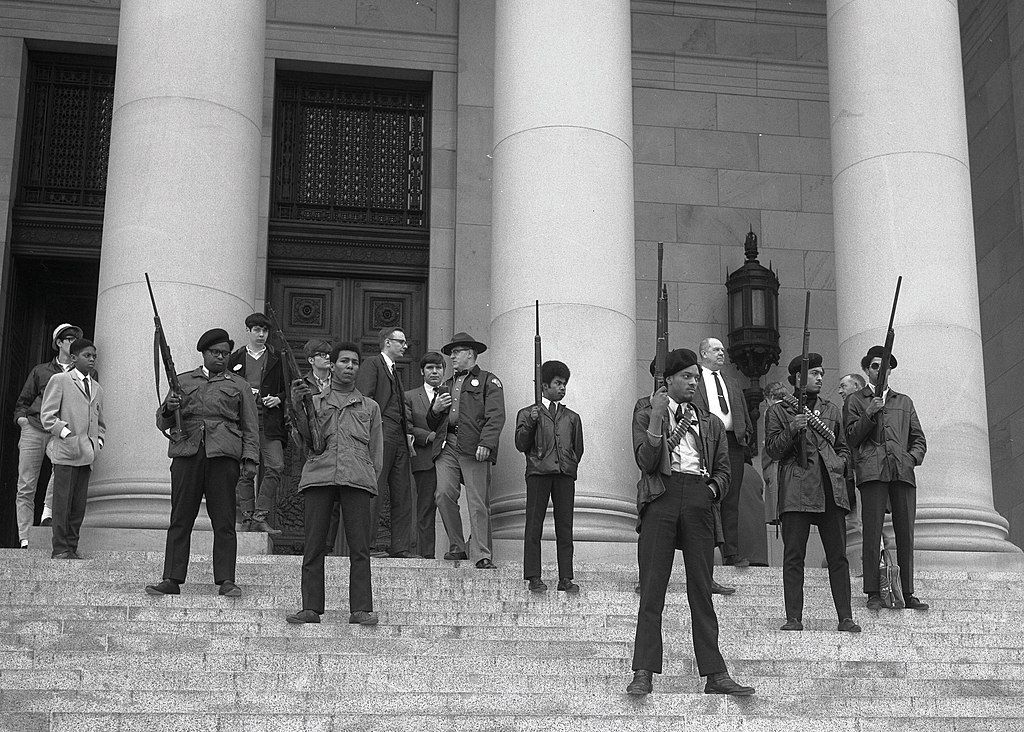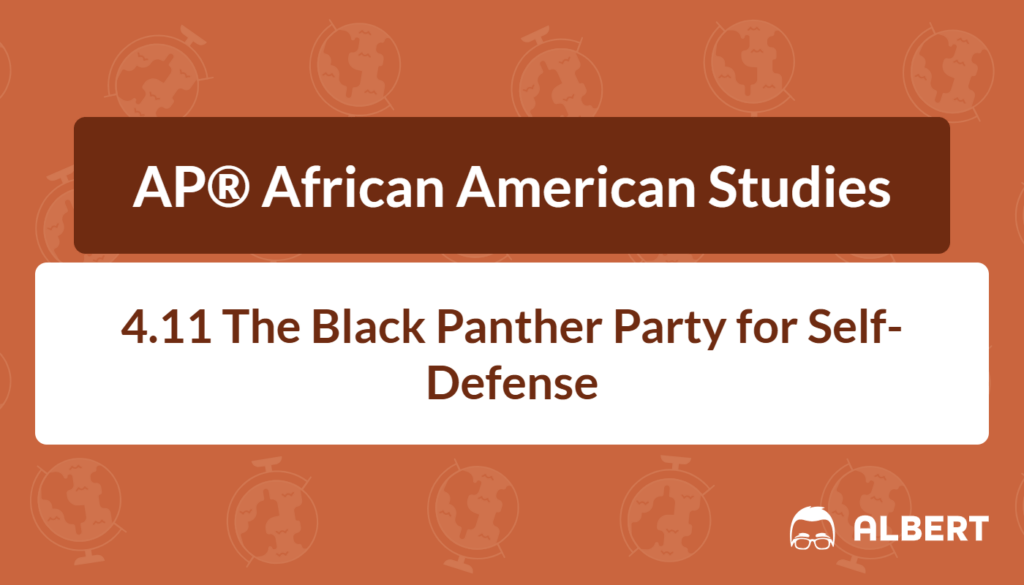What We Review
The Black Panther Party for Self-Defense: A Study Guide
Learn about the Black Panthers, their fight for justice, and their lasting impact on American history and the Black Power movement.
Introduction
The Black Panther Party began in 1966 in Oakland, California. The founders believed in defending Black communities against police brutality and injustice. They aimed to provide better housing, education, and employment for Black Americans. Their commitment to direct action was central to their approach to fighting oppression.
Understanding the Black Panthers is critical for those studying American history, especially in the context of AP® African American Studies. According to Learning Objective (LO) 4.11.A, students should be able to explain how the Black Panther Party pursued these political, economic, and social reforms. At the time, systemic discrimination kept many from basic rights and opportunities. The Black Panthers boldly challenged this system using community programs, public demonstrations, and a clear set of demands.
Origins of the Black Panther Party
The Black Panther Party for Self-Defense was greatly influenced by the ideas of Malcolm X. Malcolm X insisted on self-determination and encouraged Black Americans to protect themselves from racism by any means necessary. As a result, many young activists embraced his call for equality and self-defense.
Key influences included:
- Malcolm X’s speeches on Black empowerment
- Ongoing civil rights struggles in the 1960s
- Widespread anger over police brutality
For instance, Malcolm X’s arguments helped shape the thinking of Huey P. Newton and Bobby Seale, who founded the Black Panther Party in October 1966. They saw self-defense as a way to confront systemic violence. Consequently, the party quickly gained support among communities seeking change.
The Black Panther Ten-Point Program
The Black Panthers presented their goals in a document called the Ten-Point Program. This black panther ten point program spelled out the party’s vision for justice and equality. It included demands for freedom, housing, education, and much more. These points served as a roadmap for the party’s political and social agenda.
Breaking down each point reveals the range of their demands:
- Freedom: Calling for self-determination and an end to oppression.
- Employment: Seeking full employment for the Black community.
- End to robbery by capitalists: Criticizing exploitative business practices.
- Decent housing fit for human beings.
- Education that teaches true history.
- Exemption from military service for Black men.
- Immediate end to police brutality.
- Freedom for all Black men in prison or jail.
- Fair trials and constitutional protections.
- Land, bread, housing, education, clothing, justice, and peace.
These demands offered hope for those who felt abandoned by mainstream political parties. Furthermore, the Ten-Point Program reflected Malcolm X’s influence by emphasizing self-respect and control over Black communities.
Ideals of Self-Defense and Armed Resistance
The Black Panthers believed they had a right to protect their neighborhoods. According to Essential Knowledge (EK) 4.11.A.2, they cited the Second Amendment to justify bearing arms for self-defense. This approach was controversial because it challenged the normal image of nonviolent protest.

By publicly carrying guns, members showed strength and challenged a society that often ignored police misconduct. However, armed resistance also led to violent clashes. One example was an armed protest at the California State Capitol in 1967, where Black Panthers highlighted the hypocrisies seen in gun control laws. This event drew national attention yet fueled the FBI’s suspicion.
Armed resistance demonstrated a refusal to remain passive in the face of injustice. At the same time, critics argued that such tactics provoked even harsher crackdowns from law enforcement.
The Role of Women in the Black Panther Party
Although men often took the spotlight, women were the backbone of the Black Panther Party. EK 4.11.A.3 points out that local Black Panther offices were frequently led by women. Women also made up about half of the party’s membership. They organized community programs, managed finances, and served in leadership positions.
Their contributions included:
- Overseeing the Free Breakfast for School Children Program
- Publishing articles and managing local newspapers
- Providing healthcare services, including screenings and education
- Delivering speeches and coordinating arms training
For example, Kathleen Cleaver was a prominent woman leader who served as the party’s Communications Secretary. She was known for her effective recruiting, public speaking, and organizing. Her involvement, along with many other determined women leaders, helped shape the Black Panthers’ agenda, proving that women played a key role in the fight for freedom.
Community Programs and Social Reforms
The Black Panther Party did more than talk about freedom. It also took action. According to EK 4.11.A.3, the party expanded across dozens of cities, creating “survival programs” to address basic needs. These included:
- The Free Breakfast for School Children Program
- Free health clinics and medical services
- Legal aid offices to help with court cases
- Clothing distribution programs
The Free Breakfast for School Children Program, for example, fed thousands of students daily. This initiative was based on the idea that hungry children could not learn effectively. As a result, the Panthers filled a gap in community resources, winning the respect of local families. Similarly, health clinics and legal aid offices gave individuals access to services they might not otherwise have been able to afford.
One success story involved a local chapter that coordinated regular food giveaways. The program improved nutrition and built trust among neighbors. Because of these practical solutions, the Black Panther Party gained recognition for addressing both immediate and long-term social problems.
Opposition and Government Response
The FBI labeled the Black Panther Party a national security threat, leading to intense surveillance and infiltration. These actions were part of the FBI’s COINTELPRO (Counter Intelligence Program). Agents used various tactics to disrupt the Panthers, such as spreading false information, creating internal conflicts, and even framing members for crimes.
This government opposition led to:
- Raids on Black Panther offices
- Arrests of key members
- Internal divisions due to misinformation
- Heightened fear within local chapters
For instance, the FBI’s campaign disrupted an important community center that provided legal support and medical clinics. Consequently, the Black Panthers struggled to maintain unity and funding. Public perception changed as FBI narratives labeled them dangerous, thus overshadowing their community work.
Conclusion
The Black Panther Party for Self-Defense left a lasting impact on American society. It pursued political reforms through challenging the status quo, economic reforms by advocating for decent employment, and social reforms through robust community programs. The party’s legacy remains critical to conversations about racial justice. Even though government opposition crippled some of its operations, many lessons can be learned by examining the Panthers’ fight for dignity.
Their message resonates today in ongoing movements that seek equal treatment and resources for underserved communities. The Black Panthers illustrate the power of direct action, grassroots organization, and balanced strategies that combined armed self-defense with community service.
Required Sources
- The Black Panther Party’s Ten-Point Program, 1966
- This foundational document outlined the party’s demands for freedom, housing, education, and an end to injustice. It influenced other civil rights and social movements by providing a clear vision for Black liberation.
- Black Panther Women in Oakland, CA, 1968
- Historical images and accounts highlight the essential leadership and contributions of women activists in the party. By organizing community events, women shaped the Panthers’ local chapters and ensured the daily running of survival programs.
- Black Panther Free Food Program, 1972
- This source shows how the Black Panther Party’s free food initiatives operated. The program offered necessities like groceries and meals to those in poverty. It demonstrated the importance of grassroots efforts in combating hunger and neglect in inner-city neighborhoods.
These sources are significant because they reveal the multifaceted work of the Black Panther Party. They show that the group was not just about armed resistance; it was also about uplifting communities and protecting the rights of individuals. The documents and images from this era reinforce the core themes of political empowerment, social support, and community-led reforms that still influence activism today.
Quick Reference Chart: Key Vocabulary and Definitions
| Term | Definition |
| Black Panther Party for Self-Defense | A revolutionary Black Power organization founded in 1966, promoting self-defense and community programs. |
| Ten-Point Program | A set of demands introduced by the Black Panthers, calling for freedom, jobs, education, and more. |
| COINTELPRO | A secret FBI program aimed at surveilling, infiltrating, and discrediting political organizations. |
| Self-Defense | The right to protect oneself, often linked to the Black Panthers’ interpretation of the Second Amendment. |
| Survival Programs | Community-based aid projects by the Panthers, such as free breakfasts, health clinics, and legal aid. |
| Kathleen Cleaver | A prominent female leader in the Black Panther Party, known for her organizational and recruiting skills. |
Sharpen Your Skills for AP® African American Studies
Are you preparing for the AP® African American Studies test? We’ve got you covered! Try our review articles designed to help you confidently tackle real-world AP® African American Studies problems. You’ll find everything you need to succeed, from quick tips to detailed strategies. Start exploring now!
Need help preparing for your AP® African American Studies exam?
Albert has hundreds of AP® African American Studies practice questions, free response, and full-length practice tests to try out.









